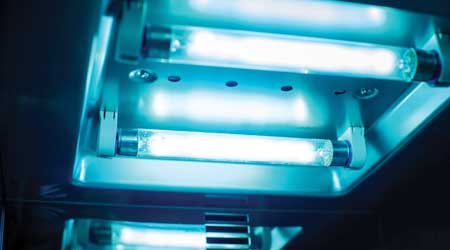What to Know about Germicidal Lighting and Coronavirus
It's the wild west of germicidal lighting right now. And though fighting pathogens like coronavirus with lighting is not new, it's still tricky.
Being able to eradicate the SARS-CoV-2 virus at the flip of a switch is about as attractive a concept as they come. UVGI (ultraviolet germicidal irradiation) technology, chiefly UV-C, has a proven record at killing or deactivating a variety of pathogens. And the technologies which can emit these wavelengths have been used in facilities for decades. However, facility managers must still be judicious in selecting and applying the UVGI technology in their facility for a variety of factors, including achieving maximum efficacy while reducing harm to facility occupants, and the facility itself.
There is a range of wavelengths which can kill or deactivate pathogens. The more potent effect is found in the UV-C range, but all UV and even some blue light has a degree of germicidal effect. Understanding that is one of the first steps of being an educated consumer of germicidal technologies. To begin with "germicidal" just means it kills microscopic pathogens. Whether it kills the tiny thing you're interested in killing depends. For example, radiation in the 405 nm range creates a creepy blue glow and also deactivates bacteria, spores, and microbes. It's used primarily in unoccupied healthcare settings, to combat hospital acquired infections. But it has no impact on viruses.
The Earth's ozone layer blocks the UV-C radiation coming from the sun, but it can be emitted by four lamp technologies. Pulsed xenon lamps put out a boatload of UV-C as well as visible light, but they are expensive and not commonly used, says Robert Karlicek, director of the Center for Lighting Enabled Systems & Applications at Rensselaer Polytechnic Institute. Mercury vapor lamps are commonly used in commercial facilities, in everything from HVAC coil defouling, to sanitizing air in ducts or through upper room disinfection fixtures, to disinfecting surfaces in rooms via robots. UV-C LEDs have a longer wavelength (265 to 280 nm versus the 254 nm of mercury vapor), and they are not as effective or powerful, says Karlicek, but they're really good at disinfecting in enclosed spaces, like a cabinet for cleaning tools or devices. Lastly, there are lamps being developed that emit in the 222 nm range, colloquially called "far UV," though UV purists are not fans of the term, Karlicek says.
Unintended consequences
UV-C is not safe for human exposure. It will cause damage to the skin and eyes. For decades it has been safely used in enclosed environments with no people in them, or in the very high reaches of tall rooms with the lamps properly shielded to prevent exposure in the lower levels of the room. Recently, downlight applications of UV-C have come on the market, paired with occupancy sensors to prevent human exposure. Facility managers should evaluate the risk posed by occupancy sensor failure.
The far UV-C technology under development is purported to be safe for human exposure, because the wavelength does not penetrate beyond the upper dead layer of skin cells. This is its selling point, as it could potentially provide continuous disinfection of occupied space. While the research is very promising, not enough is known about that specific radiation to say that it's ready for implementation in rooms that are occupied by humans, says Ernest Blatchley, environmental engineering professor at Purdue University. Some of the specifics which have yet to be determined include its effect on makeup or other products applied to skin, or its effect on open wounds (where it would have access to living tissue).
Another unknown regarding far UV-C is its effect on ozone creation, says Blatchley. Not all UV lamps create ozone, but wavelengths below 240 nm can break bonds in oxygen molecules, which leads to the formation of ozone, which can harm human lungs. Whether the lamps produce enough ozone for it to be a relevant issue is an unknown at this time, says Blatchley.
In addition to unintended consequences for humans, UV-C exposure can damage materials in a facility. Materials could become brittle, change color, or create new chemical compounds as they are exposed long-term to UV radiation. "It is not correct to view UV applications as things where the only damage that is happening is within the DNA and proteins of the target microbes," says Blatchley.
Related Topics:













